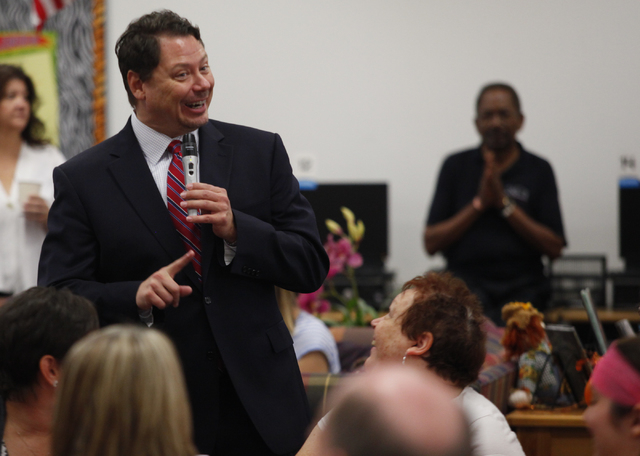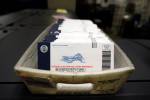A fourth of state’s public schools see downgraded ranks


A quarter of Nevada’s 604 public schools were downgraded by the Nevada Department of Education on Monday because of student performance in 2012-13, but state Superintendent of Public Instruction Dale Erquiaga insists that’s just because the bar has been raised.
“I don’t want this data to be used to say our students and our schools did worse,” Erquiaga said Monday. Because of the new accountability system and coming changes in state testing and curriculum, “We’re expecting more of them.”
In the fledgling Nevada School Performance Framework, the state began awarding one to five stars to schools annually in 2011-12. For 2012-13, the second year of the new ratings, stars are falling.
The number of high-performing, five-star Nevada schools dwindled from 112 in the 2011-12 school year to 82 schools last year under the state-created system approved by the U.S. Department of Education as a replacement for the federally mandated No Child Left Behind.
However, having 82 schools earn five stars shows the bar is still set too low, said Victor Joecks, spokesman for the conservative think tank Nevada Policy Research Institute.
A school needs to earn 77 out of 100 points to earn five stars and be given autonomy to operate under less district and state control.
“I’m very excited they’re grading schools, but that’s a large case of grade inflation,” said Joecks, noting the chasm that separates a school earning 77 points from one that earns 97.
Schools earn points in categories such as the percentage of students testing at grade level in math and reading/writing skills, percentage of students progressing at or above an expected rate, and average daily attendance. High school scores also include the graduation rate and factor in the percentage of students who are credit deficient or taking advanced courses.
The number of four-star and three-star schools also declined, meaning the state added to its list of low-performing one- and two-star schools. The state’s list of poor performers went from 119 schools to 146, a 23 percent jump.
Nearly half of all Nevada and Clark County schools earned three stars. Many would consider three stars a C grade, but schools only need to earn 50 out of 100 points to land there, Joecks noted.
“It sends gross misinformation to parents” who think their school is doing well, “but it missed as many points as it got,” he said.
RAISING THE BAR
Erquiaga, on the other hand, described the system as a “convergence of transparency and accountability.” And, he reiterated, the dropped stars of so many schools can’t be blamed on poor performance, pointing to a change in state tests used to rank schools.
The state raised the minimum pass score for its math test given to all middle school students. Also, high school students needed a score of 242 out of 500, or 48 percent, in the previous three years to pass the math test required to graduate. The minimum pass score was raised in 2012-13 to 300 out of 500, or 60 percent.
However, the pass score was set at 300, in 2008-09, and was only lowered during a transition. In 2008-09, just over 46 percent of Clark County sophomores were successful on their first attempt at the test. Only 32 percent of sophomores passed when the 300 pass score was restored last year.
Other changes have occurred in recent years and more are to come to state tests — which are being replaced — and curriculum, foreshadowing a few years of declining scores as students and staff adjust to a new system, Erquiaga warned.
However, the current decline shows students are doing worse at just coming to school. State analysts, which are midway through their look at the causes behind the falling stars, said average daily attendance is partly to blame for worsening school rankings.
Also, schools are judged by whether students, at grade or not, are growing in their skills at the expected rate per year. Whether students meet minimum pass scores isn’t taken into account here, so the raised bar can’t be to blame. The number of students meeting growth targets declined, said Andrew Parr, state education program professional.
“That had a substantial impact,” he said.
IN CLARK COUNTY
Like the state superintendent, Clark County School District Superintendent Pat Skorkowsky pointed to the raised minimum pass scores as a reason for the dropped stars at many local schools. And raising the bar is a “good thing,” he said Monday.
Stars were taken from 26 percent of Clark County schools, doubling the number of one-star schools and adding to its group of under-performing two-star schools.
District schools earning four or five stars dropped from 118 to 98, with only the three-star group remaining constant at 158 schools.
Skorkowsky said schools weren’t able to keep the momentum of 2011-12 for the rate at which individual students were progressing.
“With the schools that improved, I’m thrilled,” Skorkowsky said, pointing to the small group of 41 schools, or 12 percent, that added at least one star.
The northwest valley’s Saville Middle School was one of these schools, climbing a rung to the top of the five-star ladder. Principal Sean Davis surprised teachers with the good news before school Monday.
“The emphasis this year is to not lose the momentum,” he told the teachers at the campus near Torrey Pines and Grand Teton drives.
Skorkowsky was part of the surprise.
“We need to get in here and find out what you’re doing and replicate it in other schools,” he told staff.
Saville’s score: 79 out of 100.
“I’m glad we’re here, but nothing’s perfect,” Davis later said.
Contact reporter Trevon Milliard at tmilliard@ reviewjournal.com or 702-OVERSET FOLLOWS:383-0279.
See how your school performed.


















